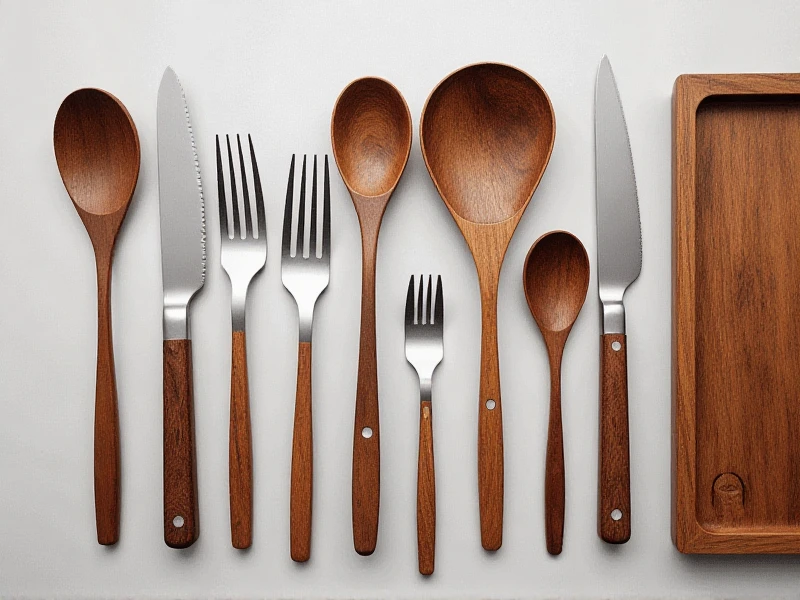The Essential Guide to Choosing Perfect Utensils for Your Kitchen
2025-06-05

Utensils form the backbone of every successful kitchen. Forget the flashy appliances for a moment – it’s the trusty spatulas, spoons, and tongs that truly get the work done, shaping meals from preparation through serving. Choosing the right ones makes cooking less of a chore and more of a pleasure, transforming chaotic moments into smooth culinary operations. Whether you’re a seasoned chef or just starting your kitchen journey, understanding the diverse world of utensils is key to efficiency and enjoyment.
Consider your utensils the silent partners in your cooking adventures. They handle high heat, scrape sticky pans, flip delicate fish, and whisk air into batters. The best ones feel like natural extensions of your hand, reliable and durable. Let's explore the main categories of essential kitchen utensils:
1. Preparation Powerhouses:
Chef's Knife & Paring Knife: Absolute fundamentals. A sharp, well-balanced chef's knife tackles dicing, chopping, mincing, and slicing. The precise paring knife handles finer tasks like peeling, trimming, and garnishing.
Cutting Boards: Protect your counters and your knives! Wood or durable plastic boards provide a safe, stable surface.
Mixing Bowls: From whisking eggs to tossing salads, nesting stainless steel or glass bowls in various sizes are invaluable.
Measuring Cups & Spoons: Accuracy matters for successful results. Have both liquid (clear with spouts) and dry measuring cups, plus a set of spoons.
Vegetable Peeler: Quickly removes skins from potatoes, carrots, apples, and more. Y-shape peelers often offer better control.
Can Opener & Bottle Opener: Staples for accessing ingredients and beverages. Comfort grip models reduce hand strain.
Grater/Zester: Adds texture and flavor effortlessly. Box graters offer versatility, while microplanes excel at zesting citrus and fine grating.
2. Cooking Commandos:
Wooden Spoons: Gentle on cookware, great for stirring sauces, soups, and sautéing. Won't scratch non-stick surfaces.
Spatulas: Essential for flipping and turning. Choose heat-resistant silicone or rubber heads for non-stick pans (slotted and solid versions are useful).
Tongs: Offer superior gripping power for turning meat, tossing pasta, serving salad, or grabbing hot items. Spring-loaded stainless steel tongs with scalloped or silicone tips are highly versatile.
Ladle: For cleanly scooping liquids like soups, stews, and sauces. Look for heat-resistant materials and a comfortable handle.
Whisk: Incorporates air and blends ingredients smoothly. Balloon whisks are great for general tasks; flat whisks work well for gravies and roux.
Slotted Spoon: Lifts solids from liquids effectively – perfect for retrieving vegetables from boiling water or serving saucy foods.
Turner/Spatula: For flipping larger items like pancakes, burgers, or fish fillets. Choose sturdy stainless steel for metal pans or heatproof plastic/silicone for non-stick. A sturdy kitchen utensil set often includes crucial cooking tools.
3. Serving & Specialized Allies:
Large Serving Spoons & Forks: Transfer family meals to the table neatly. Slotted versions help drain liquids.
Kitchen Shears/Scissors: Go beyond opening packages. Quality shears cut herbs, spatchcock chicken, trim fat, and snip pizza.
Potato Masher: Creates creamy mashed potatoes or easily breaks down cooked beans and vegetables.
Pepper Mill & Salt Grinder: Freshly ground spices elevate flavor instantly.
Colander/Strainer: Drains pasta, washes veggies, and rinses beans or grains.
Choosing the Right Utensils:
Material Matters:
Stainless Steel: Durable, hygienic, oven-safe (check handles), and dishwasher safe. Great for spoons, ladles, mashers.
Silicone: Highly heat-resistant (often up to 500°F/260°C), flexible, non-scratch for non-stick, easy to clean, and colorful. Excellent for spatulas, scrapers, basting brushes.
Wood (Bamboo/Other Hardwoods): Natural, gentle on pans, aesthetically pleasing. Requires hand washing and occasional oiling. Avoid soaking. Ideal for spoons and cutting boards.
Nylon: Softer than silicone but less heat resistant. Good budget non-scratch option (check temperature limits).
Comfort & Function: Handles should feel comfortable in your grip, providing good control and reducing fatigue during extended use. Pay attention to ergonomics.
Durability: Invest in well-constructed pieces that won't bend, break, crumble, or melt with regular use. Quality utensils are a long-term investment.
Task Fit: Don’t try to make one tool do everything. The right tool makes the job easier (like tongs for pasta or a fish spatula for delicate filets).
Maintaining Your Utensil Collection:
Read Care Labels: Follow specific cleaning instructions. Most stainless steel, silicone, and nylon are dishwasher safe. Wood generally needs hand washing.
Stick to Dishwashing Guidance: Heat and harsh detergents can degrade plastics, woods, and potentially weaken glue on attached parts like silicone heads on wooden handles.
Wood Care: Hand wash wooden utensils promptly after use, dry thoroughly, and occasionally treat with food-grade mineral oil to prevent cracking and drying.
Silicone & Nylon: Check for melting points. Avoid direct prolonged contact with high heat sources like pan edges or open flames.
Building a collection of quality utensils is fundamental to enjoying your time in the kitchen. They empower you to prepare ingredients confidently, cook safely and efficiently, and serve beautifully. Start with the essential pieces that match your cooking style, prioritize function and comfort, and choose materials that suit your cookware and lifestyle. Well-chosen utensils are not just tools; they are partners in your culinary creativity, helping you create delicious meals with ease and confidence. Fill your drawer with quality companions and make every cooking session smoother and more enjoyable!
Category: